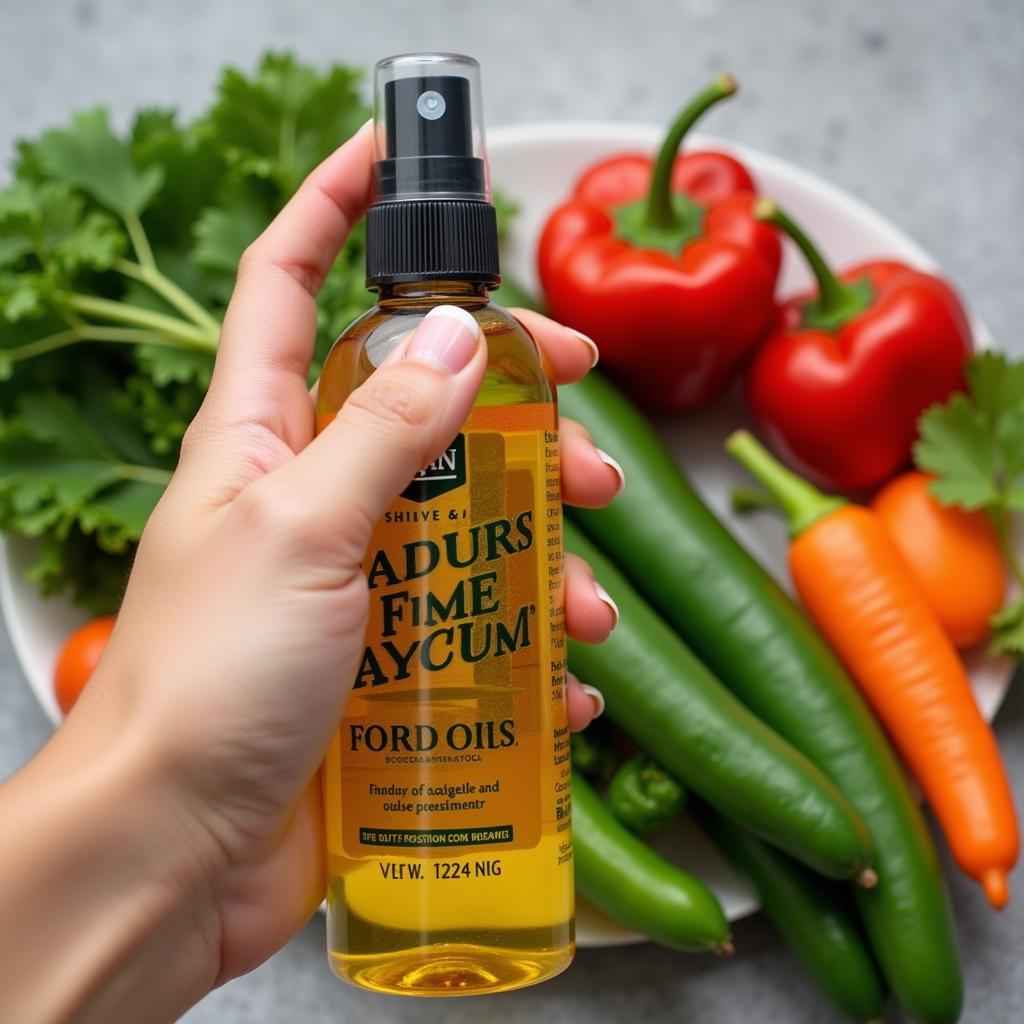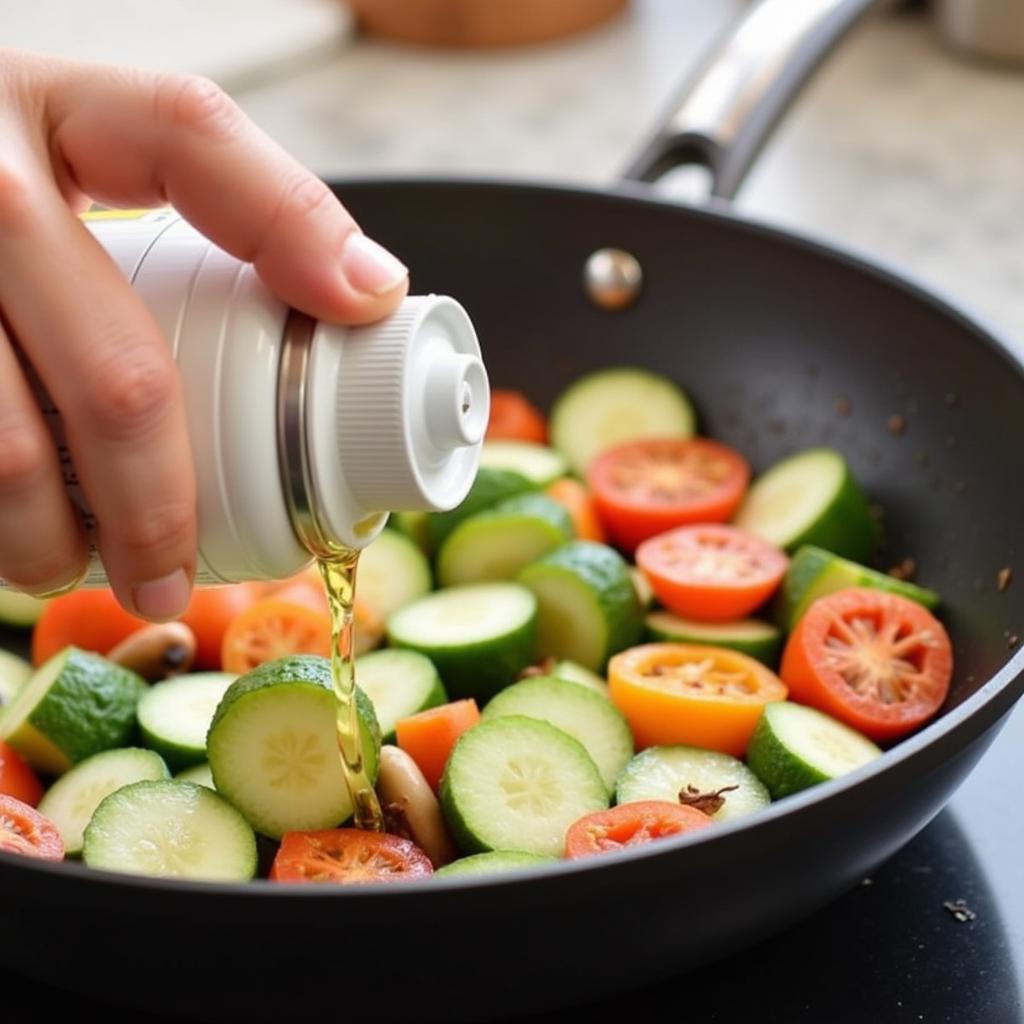Food Oil Spray has become a kitchen staple for many home cooks, promising a healthier and more convenient way to add oil to your favorite dishes. But with so many options available, it’s easy to get lost in the world of cooking sprays. This guide will delve into everything you need to know about food oil spray, from its benefits and drawbacks to how to choose the right one for your needs.
Why Use Food Oil Spray?
 Benefits of using food oil spray
Benefits of using food oil spray
Food oil spray offers several advantages over traditional oil pouring:
-
Calorie Control: One of the primary reasons people turn to food oil spray is its ability to significantly reduce calorie intake. A quick spritz delivers a thin and even layer of oil, using a fraction of what you would pour from a bottle. This can be a game-changer for those watching their weight or trying to maintain a healthy lifestyle.
-
Even Cooking: Unlike pouring oil directly into a pan, which can pool and lead to uneven cooking, food oil spray ensures your food cooks evenly. The fine mist coats the entire surface, preventing hot spots and ensuring consistent results.
-
Enhanced Flavor: By using less oil, food oil spray allows the natural flavors of your ingredients to shine through. This is especially noticeable when grilling or roasting vegetables, where a light spritz is all you need to achieve a delicious, caramelized finish.
-
Convenience: Let’s face it, measuring oil can be messy and time-consuming. Food oil spray eliminates the hassle with its easy-to-use spray mechanism, allowing for quick and effortless oil application.
Types of Food Oil Spray
Food oil spray comes in a variety of options, each with its own unique flavor profile and smoke point (the temperature at which an oil starts to burn). Some popular choices include:
-
Olive Oil Spray: Known for its health benefits and robust flavor, olive oil spray is a great choice for salads, dips, and finishing dishes. However, due to its lower smoke point, it’s not ideal for high-heat cooking.
-
Avocado Oil Spray: This spray offers a neutral flavor and a high smoke point, making it suitable for a wide range of cooking methods, from sauteing to baking.
-
Coconut Oil Spray: With its distinct coconut flavor and medium smoke point, coconut oil spray is a favorite for baking and adding a touch of sweetness to dishes.
-
Canola Oil Spray: A versatile option with a neutral flavor and high smoke point, canola oil spray is an excellent all-purpose choice for everyday cooking.
Choosing the Right Food Oil Spray
 Using food oil spray for healthy cooking
Using food oil spray for healthy cooking
When choosing a food oil spray, consider the following factors:
-
Ingredients: Opt for sprays with minimal ingredients, ideally just the oil itself and a propellant. Avoid sprays containing artificial flavors, preservatives, or additives.
-
Smoke Point: Choose an oil with a smoke point suitable for your cooking method.
-
Flavor Profile: Consider how the oil’s flavor will complement your dish. Neutral oils are versatile, while flavored oils can add a unique touch.
-
Dietary Needs: Look for sprays that align with your dietary preferences, such as organic, non-GMO, or allergen-free options.
Food Oil Spray: A Healthy Addition to Your Kitchen
Food oil spray can be a valuable tool for healthy cooking, helping you control calorie intake, enhance flavors, and simplify your cooking routine. By understanding the different types of sprays available and choosing options with minimal ingredients, you can enjoy the benefits of food oil spray while making smart choices for your health.
FAQs
1. Is food oil spray bad for you?
Food oil spray itself is not inherently bad for you. However, some sprays contain additives or preservatives that may be unhealthy. Always check the ingredient list and choose sprays with minimal and natural ingredients.
2. Can I use food oil spray on everything?
While food oil spray is versatile, it’s not ideal for all cooking applications. Avoid using it on non-stick cookware, as it can build up and damage the coating over time. It’s also not recommended for high-heat cooking methods like deep-frying.
3. How do I store food oil spray?
Store food oil spray in a cool, dry place, away from heat sources and direct sunlight.
4. What are some alternatives to food oil spray?
If you prefer not to use food oil spray, you can achieve similar results by using a pastry brush to lightly coat your pan with oil, or by using a reusable oil mister.
5. Can I make my own food oil spray?
Yes, you can make your own food oil spray by combining your favorite oil with water in a spray bottle. However, keep in mind that homemade sprays may not have the same shelf life as commercially produced options.
Do you need help with fast food hair leave conditioner, food and beverage additive n20, or food safe fruit fly spray? Explore our website for informative articles on these topics. We also have articles about kelpy plant food and ag fast food shampoo that you might find useful.
Need expert advice? Contact us at Phone Number: 02437655121, Email: minacones@gmail.com, or visit us at 3PGH+8R9, ĐT70A, thôn Trung, Bắc Từ Liêm, Hà Nội, Việt Nam. Our dedicated customer support team is available 24/7 to assist you.